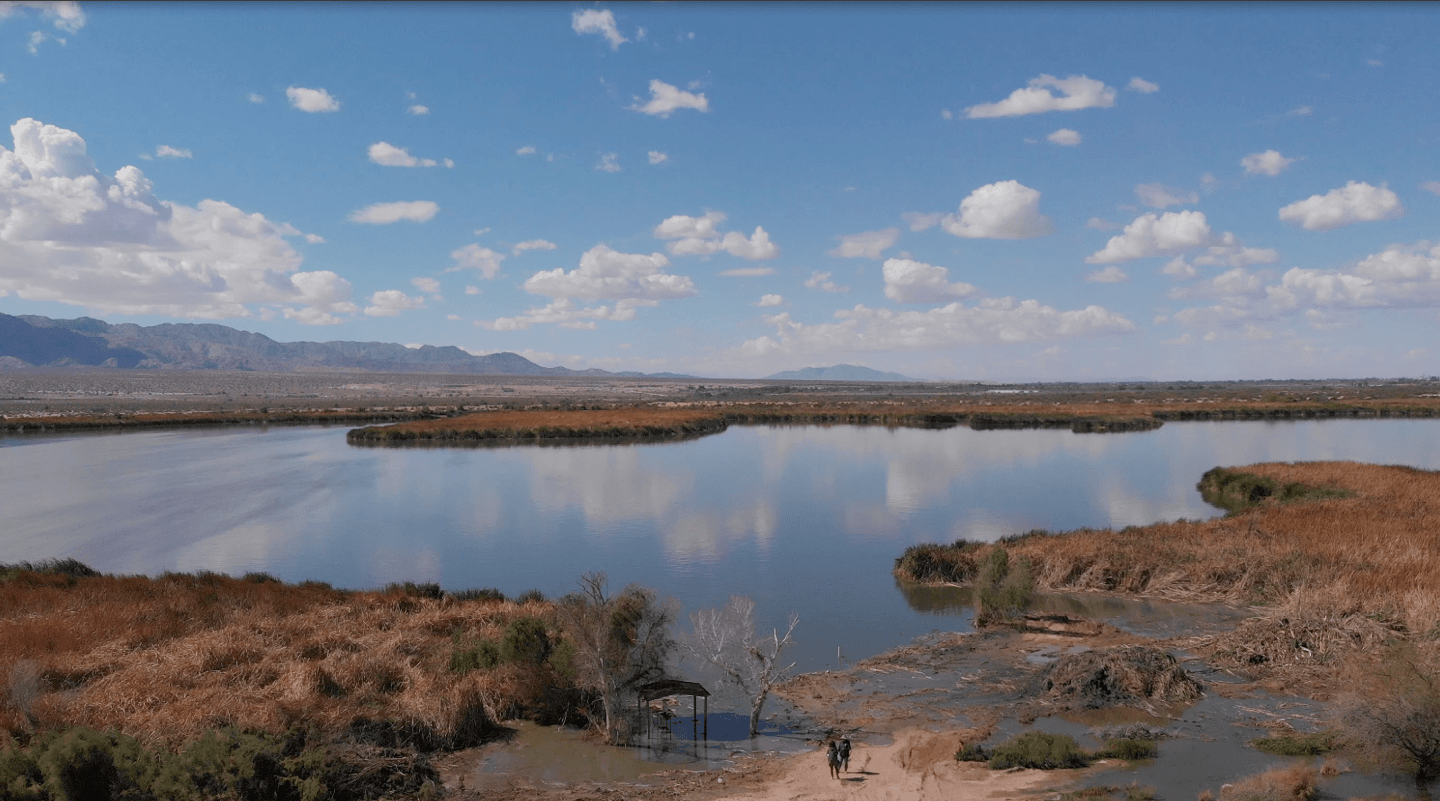In the arid region south of Mexicali, where the pale desert dominates the landscape, the Las Arenitas wetland feels like a mirage. But it is real, and is an oasis for endemic and migratory birds that cross the Colorado River delta. Here, just south of the US-Mexico border, used water from the city of Mexicali gets a second life. Half of it goes to the nearby Hardy River, in an attempt to revive ecosystems that were thought to be irrecoverable.
Historically, waterways here have been flushed full of sewage—particularly the New River, which runs off from the Colorado River northwards, crossing from Mexico into the United States and ending in the Salton Sea in California. For many years, this water course received untreated sewage from Mexicali, rendering it one of the worst-polluted rivers of its size in the US. In the 1990s, American and Mexican authorities could no longer ignore how bad the problem had become, and they began collaborating on infrastructure to lessen the pollution. And so, in 2007, south of Mexicali, the Las Arenitas treatment plant began operations.
Mexicali, which sits right on the border, generates more than 80 million cubic meters of sewage a year. Of that total, 90 percent is collected, with 46 percent of that going to Las Arenitas.
Mexicali is one of the hottest cities in the world. In summer, the region reaches 50°C.
Photograph: Pablo Romero
In the sewage plant, solids and sediments are first removed from the wastewater. Next, surface-aerated lagoons are used, where air is injected into the water to stimulate the growth of aerobic bacteria, which decompose organic matter in the presence of oxygen. The water then passes to facultative lagoons, where aerobic and anaerobic bacteria complement each other, the latter degrading organic matter that the former could not. Finally, the water reaches the maturation lagoons, where the remaining solids settle out.
When it launched, this new system worked. “In the beginning, the plant did not perform ideally,” says Edith Santiago, deputy director of the Colorado River delta program in Mexicali at the conservation nonprofit the Sonoran Institute. To combat this, some organizations proposed to the water management agency that they should use the surrounding land, which decades ago housed a lake, to create an artificial wetland that would give the water additional cleanliness.
Such a plan, as well as helping with the city’s sewage problem, would also help partially restore the local landscape to its former state. Before the overexploitation of the Colorado River, its delta crossed Baja California and Sonora until it met the waters of the Gulf of California, resulting in more than 400,000 hectares of wetlands. Although the river’s course has become a ghost, about 15 percent of those wetlands have survived, harboring an invaluable biodiversity of plants and animals. Seeking to mimic that strength, the Las Arenitas artificial wetland is a pause to the devastation of the local landscape.
Edith Santiago, deputy director of the Colorado River delta program in Mexicali at the Sonoran Institute.
Photograph: Pablo Romero
Construction of the wetlands began in 2009, a collaboration between the federal and state governments, water agencies, and investments obtained by the conservation nonprofit Pronatura Noroeste and the Sonoran Institute. In addition, they replaced obsolete equipment and made repairs to the plant.
“Wetlands are the kidneys of the planet—they help to filter and clean the water, to remove particles through the different plants,” explains Santiago. This process, where plants naturally cleanse water, is known as phytoremediation, and it occurs both underground in the roots of tule and alkaline reed, but also on the surface of the wetland waters, where microorganisms that degrade pollutants live.
Microscopic life within the wetlands cleanses the water in diverse ways, such as by transforming nitrogen into other substances and by assimilating phosphorus into its own biomass. In addition, physical processes such as sedimentation occur, in which smaller particles fall to the bottom of the water body.
The Revive the Colorado River Alliance reports that 50 percent of the water leaving the wetland flows into the Hardy River.
Photograph: Pablo Romero
The wetlands’ battle to maintain their balance is titanic, as the water treatment plant has been operating above capacity since 2013. The plant has an installed capacity of 840 liters per second, but it reaches 1,044 liters per second in some months. An expansion of the plant, while urgent, is yet to happen—though it has been on the table for more than five years.
It’s possible to smell when the wetland ecosystem is out of kilter: The decomposition of organic matter there can generate unpleasant odors when these systems are under stress or out of balance, giving the environment an earthy, pungent aroma.
Assessing the quality of the treatment system’s discharges is costly, and Santiago points out that there are two key things that could improve the processing of the water here further still: “Implementing better water use in the city, and new technology such as activated sludge in the plant, which uses less space than the lagoons and is faster.”
The Las Arenitas complex has transformed 99 hectares into a wetland.
Photograph: Pablo Romero
When the wetland was designed, it was agreed that 30 percent of its annual water volume would flow along the Hardy River to the south for environmental use—that is, to sustain the life of this river, but also for the benefit of local communities, among them, the Cucapa indigenous group. The amount flowing into the Hardy River has now risen to 50 percent. “That the water from Las Arenitas flows along the Hardy River generates environmental potential; many species of birds and other wildlife use this area or live in it,” says Santiago.
Plants in wetlands help the process through phytoremediation.
Photograph: Pablo Romero
Re-creating wetlands in the region also has a unique ecological benefit. In 2009, the first bird census in the area yielded about eight species and fewer than 100 birds in total. Six years later, researchers counted 160 different species, with a peak count of 18,000 birds. They have recorded Yuma clapper rails, brown pelicans, peregrine falcons, and northern shovelers.
An assessment of ecosystem services provided by the wetlands in the arid zone of Mexicali, published in 2023, highlighted the system’s high potential for regulating water flows, promoting environmental education, and recharging the local aquifer.
That last point is an important one. The city of Mexicali depends on the Colorado River and its underground water reserves, but it uses water at an unsustainable rate. Annual recharge of the Mexicali Valley aquifer is 520.5 cubic hectometers (hm3), but more water is withdrawn from this underground store each year than reenters it (783.12 hm3). Meanwhile, the Colorado River is being squeezed to exhaustion, and is approaching a collapse that climate change is accelerating. Without Las Arenitas, the situation would be even worse, but drastically more needs to be done to balance the region’s water use.
“My dream for Las Arenitas is that the community will come to enjoy it, but, at the same time, that there will be better water use in our homes so that less water reaches this area in poor conditions,” Santiago says.
This story originally appeared on WIRED en Español and has been translated from Spanish.




